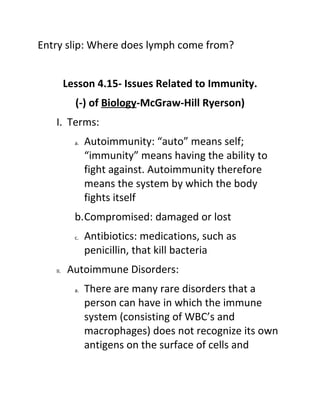
Where does lymph come from
- 1. Entry slip: Where does lymph come from? Lesson 4.15- Issues Related to Immunity. (-) of Biology-McGraw-Hill Ryerson) I. Terms: a. Autoimmunity: “auto” means self; “immunity” means having the ability to fight against. Autoimmunity therefore means the system by which the body fights itself b.Compromised: damaged or lost c. Antibiotics: medications, such as penicillin, that kill bacteria II. Autoimmune Disorders: a. There are many rare disorders that a person can have in which the immune system (consisting of WBC’s and macrophages) does not recognize its own antigens on the surface of cells and
- 2. attempts to kill the cells as they would for a foreign pathogen. i. Rheumatoid Arthritis: An autoimmune condition by which the body begins to attack its own tissues, with the biggest impact on the smooth cartilage in the joints between bones. When this cartilage breaks down, the bones rub on each other and cause extreme pain and deformity. Cause appears to be genetic. No known cure, although pain killers are used for pain. ii. Lupus: An autoimmune disorder nine times more common in women than in men. Like Rheumatoid Arthritis, the joints are affected. Lupus is known for its attacks on the skin of the patient, with rashes breaking out and then going away. Cause appears to be genetic. No known cure. iii. Multiple Sclerosis: An autoimmune disorder in which the nerves of a
- 3. person are attacked. The nerves connecting the brain the muscles are what conduct signals for the muscles to move, from the brain. Therefore, if the nerves are broken down, the movements of the muscles will be very shaky and uncontrolled: the classical sign of M-S. Cause: genetic, cure: unknown. III.Organs Transplants: a.In the case of a patient who received an organ transplant, their body would naturally recognize the implanted organ as “foreign” and try to kill it, the same way it would to a bacterial infection. i. One way or trying to reduce the likelihood of “rejection” is to find a donor that has similar “type” of organ, just like for blood-group types. Example: recipient with blood type A- can safely get blood from a donor with type A- or type O- blood.
- 4. ii. Another way is to give the recipient “anti-rejection drugs”, which are medications that cause leukocytes and lymphocytes to either work very poorly or to die off. Unfortunately, the patient has to be monitored for signs of simple infections or illness now, as their immune system does not work well. IV.Compromised Immunity: a.Some people are born with or acquire immune systems that either work very poorly or are absent. These conditions do not kill the person, but the most common cold or flu could... i. Primary Immunodeficiency (PID): A very rare disorder characterized by a child constantly getting very sick starting at a young age. Treated by vaccine (for common cold, flu, etc..) and long-tern antibiotics use.
- 5. ii. Acquired Immunodeficiency (AID): Some medications and treatment for other disorders can actually kill off vast amounts of your own WBC’s. Treatments for cancer, particularly leukemia (cancer of WBC’s) will compromise your immune system, as will anti-rejection drugs for organ transplants. iii. Acquired Immunodeficiency Syndrome (AIDS): A disease by which lymphocytes and macrophages are infected with the HIV virus, leaving them useless. When all of these disease fighting cells are infected, a person’s immune system is absent and they have AIDS. AIDS is spread by sexual contact and is not necessarily deadly these days, as long as the patient is treated with “anti- retroviral” medications. V. Youtube search: a.none
- 6. VI.Homework: a. Research what is meant by the word “quarantine”. Write its definition and give two examples of when it might be used? Due tomorrow.